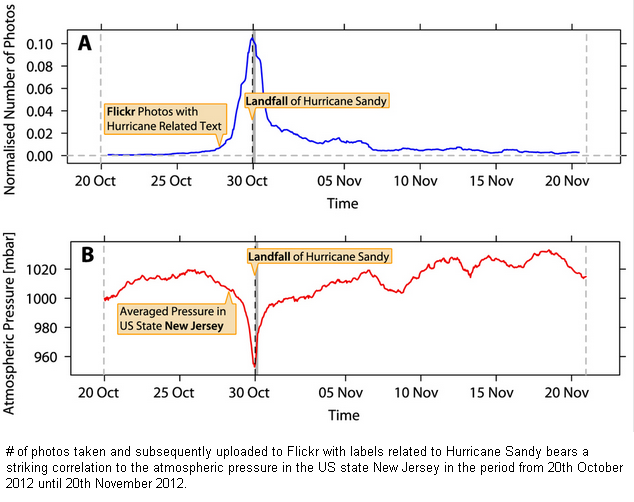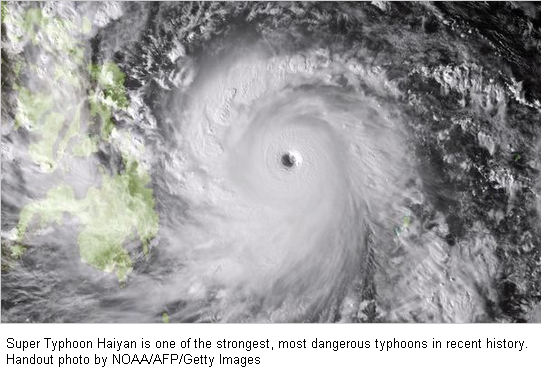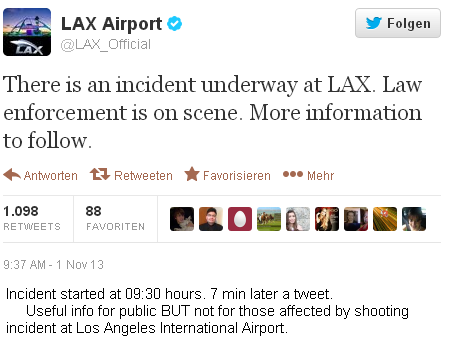Two questions about big data, social media and natural disasters:
- Can Twitter help with disaster rescue? LAX shooting incident
- What about Flickr for disaster management? Hurricane Sandy, Typhoon Haiyan
Keywords: communication, disaster rescue, disaster management, big data, ROI, return on investment, strategy
Please answer my questions at the end – I love and need your feedback to decide.
This is the first entry in a series of posts about using big data to help emergency services, organisations, NGOs (non-governmental organisations) and health agencies, etc.
Business analytics: Dealing with the data deluge
By the way, do what 5,000 other subscribers have done – sign up for our FREE blog newsletter!
1. Does Twitter work for disaster rescue?
November 1, 2013 was probably the first time any airport – Los Angeles International (LAX) – referred the media, and the public to a Twitter handle as the official source for news updates. The shooting incident started at 9:30 am local time. The incident resulted in one TSA (Transportation Safety Administration) officer’s death and three other people being injured, including two more TSA employees. During that day, Katherine Alvarado – the LAX public relations officer who had personally launched the Twitter account in 2009 – sent out 112 public tweets (we grabbed them here – download the pdf file – interesting reading about the LAX shooting incident). Thousands of travellers were left stranded that day.
Bottom line
Unless you were following the Twitter @LAX_official account run by Alvarado and her team before the crisis, you probably got the first alert via your car radio – not Twitter. Understandable, of course, considering that 92 percent of the US population listens to radio, and 47 percent do so primarily in their vehicle. Unfortunately, knowing about the event at around 9:00 am probably failed to prevent you from having left your house to catch your flight that day – otherwise it might have saved you from fighting traffic. Staying home would have been the right thing to do, since your flight was surely among the more than one thousand that were cancelled. So did Twitter change anything? Maybe, but doubtful. Besides satisfying news hounds with tidbits it did little else… Good read: Twitter in a crisis: 6 tips for a faster rescue
2. What about Flickr for disaster management?
It seems as if Twitter adds limited value to a crisis situation, but can Flickr do better? Put differently, can social networks like Twitter help in situations of natural disaster when emergency services are stretched to the limit? A recent study tried to shed some light on this issue. Researchers were able to show a positive correlation between the number of pictures of Hurricane Sandy posted on Flickr and the atmospheric pressure in New Jersey as the hurricane crossed the US state in October 2012. Some pointed out that the positive correlation between Flickr photo uploads and Hurricane Sandy could simply have been the result of media coverage of the storm. But that is nonsense, because Flickr is a platform where people upload their personal pictures. It is unlikely that a person takes a picture and uploads it solely because of media coverage about a storm. This tells us that people were reacting to Sandy, taking pictures about the disaster when the storm hit and uploading them to Flickr. The study’s authors point out that what we do not know is where these people uploaded pictures from (e.g., region of the US or maybe Canada).
Bottom line
Because Typhoon Haiyan (November 8-9, 2013) damaged infrastructure in the Philippines so severely, people were unable to much of anything internet-related. While Flickr and other networks provide researchers with opportunities to track things using large volumes of publicly-available data, we are still waiting to see if it helps with disaster recovery (e.g., see how Twitter failed people during the Pakistan disaster, or watch out, another set of voodoo metrics). Useful and good read: Preis, Tobias;, Moat, Helen, Susannah; Bishop, Steven, R.; Treleaven, Philip; Stanley, Eugene (November 5, 2013). Quantifying the digital traces of Hurricane Sandy on Flickr. Nature, Scientific Reports, 3, Article number: 3141. doi: 10.1038/srep03141 Retrieved November 6, 2013 from ====>http://www.nature.com/srep/2013/131105/srep03141/full/srep03141.html 
Conclusion – what social media cannot do
This illustrates that in cases like the LAX shooting, Twitter can be used to keep news media informed, as well as the interested public. This also works well if police chiefs and other officials refer to such a channel during press conferences as being the official news source as happened with that incident. In this way micro-blogging can help automate the creation of news to some degree, and public outreach. But how much this improves the situation is not yet clear. As my superficial analysis of the 112 tweets suggests, they contain a lot of fluff. Regarding the Flickr study, some have raised the question of whether such ‘big data’ be used to track other crises in addition to the less problematic spreading of fashions or even specific products (BIG DATA – Hurricane Sandy – Flickr Uploads) However, I have yet to be convinced that such work can help governments measure the impact of disasters, as the authors suggest. The authors were also unable to tell, leaving it to others to find the answers, if any. Useful and good read: Fire season is no longer a 3 month affair – California Governor’s Office of Emergency Services, What do BP, big banks and Putin share? Great crisis management
Source: Typhoon Haiyan: Twitter and Flickr to the rescue?
What is your opinion? Can social media like Twitter help during natural disasters like earthquakes or hurricanes? Do you have other examples where social media made a difference? Have you ever uploaded pictures or tweeted during a natural disaster? Thanks again for sharing your thoughts and insight – I appreciate it, as always.
Find more on Google – Twitter, Flickr, Google, disaster, rescue management, US ambassador, metrics
If you are a CyTRAP BlogRank user, please ensure your blog’s robot file allows us to crawl your site. We explain it here.
The author: This post was written by social media marketing and strategy expert Urs E. Gattiker, who also writes about issues that connect social media with compliance, and thrives on the challenge of measuring how it all affects your bottom line. His latest book, Social Media Audit: Measure for Impact, appeared in November 2012 (Springer Science Publishers), and he is currently hard at work on the next one. Connect with CyTRAP BlogRank on Google+ or the author using: Email | Twitter | Google+ | Xing




Pingback: detect outbreak,infectious disease,big data fail,,call-data records,CDSR